Intervention in agricultural markets
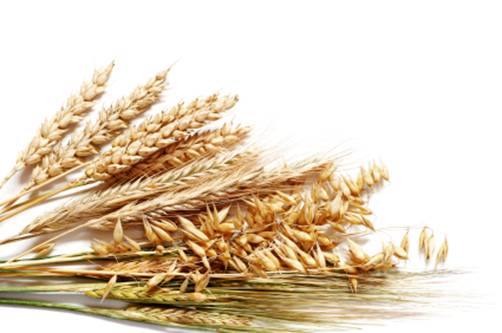 One area where national governments and the EU intervene extensively is in agricultural markets. The aim of this intervention is normally to guarantee farmers a stable and secure income as agricultural markets can fluctuate significantly. One of the largest intervention schemes is the Common Agricultural Policy (CAP) run by the European Union (EU).
One area where national governments and the EU intervene extensively is in agricultural markets. The aim of this intervention is normally to guarantee farmers a stable and secure income as agricultural markets can fluctuate significantly. One of the largest intervention schemes is the Common Agricultural Policy (CAP) run by the European Union (EU).
Commodity agreements
These may take the form of attempts to stabilise prices, through the operation of a buffer stock scheme or attempts to raise prices by forming a producers' cartel and restricting supply through the use of quotas.
Buffer stock schemes
Firstly, we will consider the operation of buffer stock schemes that have existed on and off since the 1920s for a range of commodities including wheat, tin, rubber, coffee, sugar and cocoa. All of these have eventually failed for one reason or another, so there are no prominent examples to consider.
So, what is a buffer stock scheme?
Buffer stock schemes are operated by a central authority (buffer stock agency) and aim to stabilise prices and protect producers from sudden shifts in demand and supply (often supply in the case of agriculture). This is done by the buffer stock agency intervening in the market. If there is too much supply, forcing the price down, the buffer stock agency will increase demand by buying up stocks and price will be pushed up again. If there is a shortage of supply, forcing the price up, the agency will release stocks onto the market forcing the price down. This can, of course, only occur for products that can be stored.
A buffer stock makes use of a price band. Figure 1 below shows the effect of setting up a buffer stock scheme for coffee. If the market is within the two boundaries set by the agency, no action is taken. However, if the market price moves outside the boundaries, the buffer stock operators will intervene.
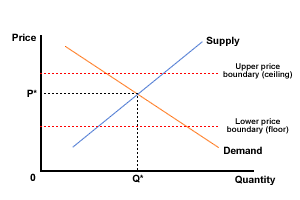
Figure 1 Buffer stock for coffee
If there is a very good harvest of coffee, the supply curve will shift to the right and the price would fall below the boundary. The buffer stock operators would then step in to increase demand to keep the price within the boundary. This is shown in Figure 2 below.
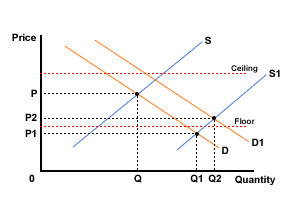
Figure 2 Buffer stock - good harvest
The bumper harvest causes the supply curve to shift to S1. This would initially cause the price to fall below the lower boundary to OP1. By buying up stocks, the agency shifts the demand curve to D1 and brings price back within the upper and lower boundaries to OP2.
If there is a poor harvest of coffee, the supply curve will shift to the left and the price would increase above the upper boundary. The buffer stock operators would then step in to increase supply by selling stocks and this would push price down below the upper boundary. This is shown in Figure 3 below:
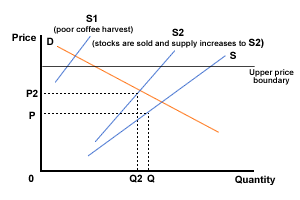
Figure 3 Buffer stock - poor harvest
Problems of a buffer stock scheme
There are a number of possible problems related to buffer stock schemes and these may include:
- Problems of storage, storage and administration costs and perishability, particularly if there are too many years of bumper harvests.
- Difficulty of setting appropriate floor and ceiling prices. If buffer stock managers have to consistently intervene at the floor price, they will have to keep buying and may run out of finance. If they have to keep intervening at the ceiling price, they will run out of stocks to put on the market.
- Problems of inadequate supplies if there are too many years of bad harvests.
- Problems of financing the buffer stock if there are too many years of good harvest - funds have to be contributed by the members.
- Problems of keeping prices artificially high if there are close substitutes available, e.g. rubber/rubber substitutes
- Difficulties in maintaining the agreement on prices in that some producers may be underproducing and could improve their individual position by cutting price and raising output. This is particularly the case where producers are scattered in different countries.
Cartel arrangements
Such schemes have been attempted in the case of rubber, tin, coffee and sugar, and involve the formation of a single selling organisation, i.e. a cartel, to restrict output of individual members through the issuing of quotas. Thus, when prices need to be increased, members would be ordered to reduce their output in accordance with their quota allocation. This is illustrated in Figure 3 below.
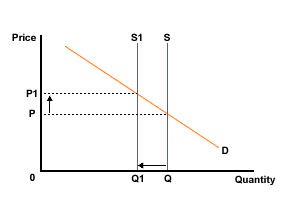
Figure 3 Cartel - use of quotas to restrict output
The supply of primary commodities tends to be perfectly inelastic in the short run, so the cartel requiring a reduction in output would shift the supply curve to the left from S to S1 and raise the price from OP to OP1.
Such schemes have suffered from some of the same problems that have beset buffer stock schemes, i.e. problems of maintaining the cartel and the switch towards substitute goods if prices are kept too high.
